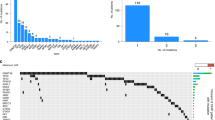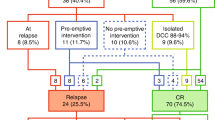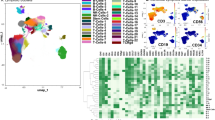Abstract
The aim of this investigation was to examine the possible clinical significance of the kinetics of bone marrow (BM) tumor load during the course of sequential high-dose therapy (HDT) as assessed by quantitative PCR in patients with multiple myeloma. In 20 patients with multiple myeloma (MM) treated with two consecutive cycles of HDT followed by autologous peripheral blood stem cell transplantation (PBSCT), clonotypic cells in the peripheral blood (PB) and BM were quantitated by PCR using allele-specific oligonucleotides (ASO) prior to the first, immediately prior to the second, and after the second HDT. The median proportion of clonotypic cells in the BM was 1.27% before the first HDT (range, 0.03–70%), 0.17% after the first (range, 0.001–22%), and 0.05% after the second HDT (range, 0.00009–1.44%). The median number of circulating clonotypic cells was 65/ml (range, 0.9–10842) prior to HDT, 2.7/ml (range, 0–315) after the first, and 3.5/ml PB (range, 0.7–97) after the second HDT. While the median BM tumor load decreased during the first (P = 0.03) and second (P = 0.044) HDT cycles, only the first cycle resulted in a reduction of clonotypic cells in the PB (P = 0.00078 and P = 1.0, respectively). In seven patients, the BM tumor load did not decrease below the initial level after one or two cycles of HDT. All of these patients developed progressive disease (median, 19 months post first cycle; range, 10–21). Of the remaining 13 patients, only four relapsed (18, 19, 21 and 22 months after the first cycle of HDT), while nine remain in response (median follow-up, 29 months; range, 18–41) (log-rank test P = 0.0009). Our results indicate that the kinetics of the BM tumor load is a predictive parameter in patients with MM and identifies those patients who could benefit from further therapy including new treatment modalities. Bone Marrow Transplantation (2000) 26, 851–858.
This is a preview of subscription content, access via your institution
Access options
Subscribe to this journal
Receive 12 print issues and online access
$259.00 per year
only $21.58 per issue
Buy this article
- Purchase on Springer Link
- Instant access to full article PDF
Prices may be subject to local taxes which are calculated during checkout



Similar content being viewed by others
References
Attal M, Harousseau JL, Stoppa AM et al. A prospective randomized trial of autologous bone marrow transplantation and chemotherapy in multiple myeloma New Engl J Med 1996 335: 91–97
Barlogie B, Jagannath S, Desikan KR et al. Total therapy with tandem transplants for newly diagnosed multiple myeloma Blood 1999 93: 55–65
Attal M, Payen C, Facon T et al. Single versus double transplant in myeloma: a randomized trial of the ‘Inter Groupe Francais Du Myelome’ (IFM) Bone Marrow Transplant 1998 21: S206 (Abstr. 718)
Desikan KR, Tricot G, Dhodapkar M et al. Melphalan plus total body irradiation (MEL-TBI) or cyclophosphamide (MEL-CY) as a conditioning regimen with second autotransplant in responding patients with myeloma is inferior compared to historical controls receiving tandem transplants with melphalan alone Bone Marrow Transplant 2000 25: 483–487
Gahrton G, Svensson H, Cavo M et al. Allogeneic and syngeneic transplantation in multiple myeloma. VIIth Int. Workshop on Multiple Myeloma, Stockholm, September 1999 (Abstr. 134)
Durie BGM, Salmon SE . A clinical staging system for multiple myeloma: correlation of measured myeloma cell mass with presenting clinical features, response to treatment, and survival Cancer 1975 36: 842–854
Goldschmidt H, Martin H, Serke S et al. Tandem autologous transplantation (tpx) for multiple myeloma (MM): results of a German multicenter study Blood 1998 92: 662a (Abstr. 2730)
Blade J, Samson D, Reece D et al. Criteria for evaluating disease response and progression in patients with multiple myeloma treated by high-dose therapy and haemopoietic stem cell transplantation. Myeloma Subcommittee of the EBMT. European Group for Blood and Marrow Transplant Br J Haematol 1998 102: 1115–1123
Chomczynski P, Sacchi N . Single-step method of RNA isolation by acid guanidinium thiocyanate-phenol-chloroform extraction Anal Biochem 1987 162: 156–159
Cremer FW, Kiel C, Wallmeier M et al. A quantitative PCR assay for the dectection of low amounts of malignant cells in multiple myeloma Ann Oncol 1997 8: 633–636
Aubin J, Davi F, Nguyen-Salomon F et al. Description of a novel FR1 IgH PCR strategy and its comparison with three other strategies for the detection of clonality in B cell malignancies Leukemia 1995 9: 471–479
Brisco MJ, Tan LW, Orsborn AM et al. Development of a highly sensitive assay, based on the polymerase chain reaction, for rare B-lymphocyte clones in a polyclonal population Br J Haematol 1990 75: 163–167
Kwok S, Higuchi R . Avoiding false positives with PCR Nature 1989 339: 237–238
Taswell C . Limiting dilution assays for the determination of immunocompetent cell frequencies J Immunol 1981 126: 1614–1619
Vescio R, Stewart A, Ballester O et al. Increase in circulating tumor cell burden during mobilization chemotherapy predicts for relapse after autologous transplantation in multiple myeloma patients Blood 1997 90: 565a (Abstr. 2515)
Björkstrand B, Ljungman P, Bird JM et al. Double high-dose chemoradiotherapy with autologous stem cell transplantation can induce molecular remissions in multiple myeloma Bone Marrow Transplant 1995 15: 367–371
Billadeau D, Prosper F, Verfaillie C et al. Sequential analysis of bone marrow and peripheral blood after stem cell transplant for myeloma shows disparate tumor involvement Leukemia 1997 11: 1565–1570
Kiel K, Cremer FW, Rottenburger C et al. Analysis of circulating tumor cells in patients with multiple myeloma in the course of high-dose therapy with peripheral blood stem cell transplantation Bone Marrow Transplant 1999 23: 1019–1027
Berenson J, Wong R, Kim K et al. Evidence for peripheral blood B lymphocyte but not T lymphocyte involvement in multiple myeloma Blood 1987 70: 1550–1553
Takishita M, Kosaka M, Goto T et al. Cellular origin and extent of clonal involvement in multiple myeloma: genetic and phenotypic studies Br J Haematol 1994 87: 735–742
Bergsagel PL, Smith AM, Szczepek A et al. In multiple myeloma, clonotypic B lymphocytes are detectable among CD19+ peripheral blood cells expressing CD38, CD56, and monotypic Ig light chain Blood 1995 85: 436–447
McSweeney PA, Wells DA, Shults KE et al. Tumor-specific aneuploidy not detected in CD19+ B-lymphoid cells from myeloma patients in a multidimensional flow cytometry analysis Blood 1996 88: 622–632
Gerard CJ, Olsson K, Ramanathan R et al. Improved quantitation of minimal residual disease in multiple myeloma using real-time polymerase chain reaction and plasmid-DNA complementarity determining region III standards Cancer Res 1998 58: 3957–3964
Acknowledgements
We are indebted to Robert A Vescio for his critical reading of the manuscript. We thank Hildegard Bethäuser, Maria Dörner, and Carmen Kröner for excellent technical assistance.
Author information
Authors and Affiliations
Rights and permissions
About this article
Cite this article
Cremer, F., Ehrbrecht, E., Kiel, K. et al. Evaluation of the kinetics of the bone marrow tumor load in the course of sequential high-dose therapy assessed by quantitative PCR as a predictive parameter in patients with multiple myeloma. Bone Marrow Transplant 26, 851–858 (2000). https://doi.org/10.1038/sj.bmt.1702628
Received:
Accepted:
Published:
Issue Date:
DOI: https://doi.org/10.1038/sj.bmt.1702628
Keywords
This article is cited by
-
Controversies in the Assessment of Minimal Residual Disease in Multiple Myeloma: Clinical Significance of Minimal Residual Disease Negativity Using Highly Sensitive Techniques
Current Hematologic Malignancy Reports (2014)
-
In non-transplant patients with multiple myeloma, the pre-treatment level of clonotypic cells predicts event-free survival
Molecular Cancer (2012)
-
Hematopoietic stem cell mobilization with intravenous melphalan and G-CSF in patients with chemoresponsive multiple myeloma: report of a phase II trial
Bone Marrow Transplantation (2005)
-
Molecular monitoring of the tumor load predicts progressive disease in patients with multiple myeloma after high-dose therapy with autologous peripheral blood stem cell transplantation
Bone Marrow Transplantation (2001)



